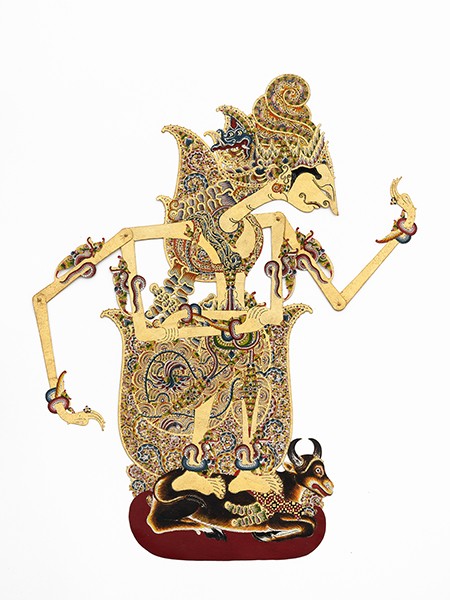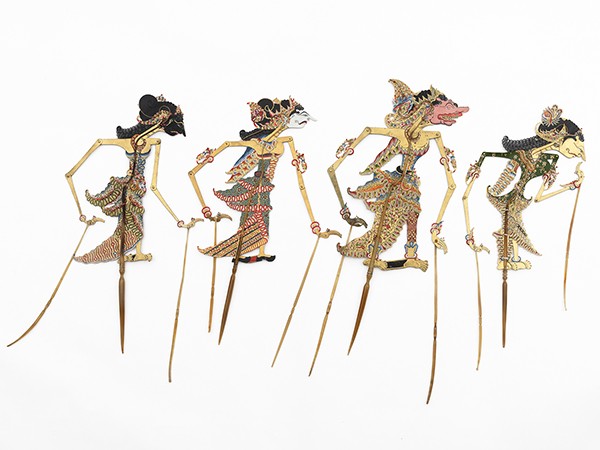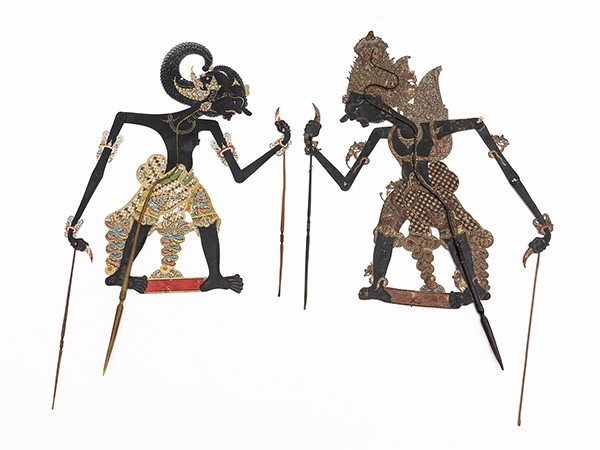LIGHT AND SHADOW: WAYANG KULIT FROM JAVA
11.05.2020
Vanessa von Gliszczynski, curator Southeast Asia, explains the centuries-old history of the wayang kulit and provides some insights into its cosmology.
For generations, the Javanese shadow puppet theatre called wayang kulit has fascinated ethnologists, musicologists, fans of Indonesia, and tourists. While wayang kulit performances would once run throughout the night, nowadays these productions of epic stories are frequently abridged to suit the fast pace of our media-driven age.
In late 2019 the Weltkulturen Museum received a gift of around 200 wayang kulit figures from Annegret Haake, a collector from Kronberg near Frankfurt am Main. Not only do these figures supplement the existing collection, they also come with detailed documentation which makes it easier to identify the numerous wayang characters. We view this as a welcome opportunity to present a more comprehensive introduction to wayang kulit.
The origin of the wayang kulit
Wayang kulit is a kind of shadow puppet theatre that comes primarily from the Indonesian island of Java, particularly the sultanates of Yogyakarta and Surakarta, whose styles also differ from each other to some extent. In Surakarta the divine figures wear clothing such as jackets and shoes, while in Yogyakarta they do not. Wayang kulit has changed considerably throughout its centuries-long existence, and features a mixture of Indian, Islamic and Javanese elements. The stories and characters in wayang kulit are mainly borrowed from the ancient Indian epics Mahabarata and Ramayana. However, they have been given a Javenese flavour in certain respects and local characters have been added: for example, the beloved clown Semar – himself a god and the loyal companion of the Pandava brothers from the Mahabarata – does not appear in the Indian epic.
Stories that portray the universe
Concealed behind wayang kulit and the characters it depicts there is an entire cosmology, which is also referenced – albeit to an ever decreasing degree – in everyday life and popular culture. The Javanese believe that the stories in wayang kulit portray the universe. The tales are traditionally adapted to fit the reason for the performance: a love story for a wedding, a tale of becoming a man to accompany a circumcision. The stories influence and reflect the events on earth. Consequently, the finale of the Mahabarata – the battle between Pandavas and Kauravas which sees the downfall of the great (Javanese) kingdom of Astinapura – is not performed due to a fear that it might lead to the collapse of the Javanese sultanates.
The characters
Just like the events portrayed in the epics – only extracts of which are ever performed – are regarded as mirroring the universe, the characters that appear in them are figures of identification for the real world. Although the details are no longer taught in their entirety today, as recently as fifty years ago any Javanese child would be able to describe the appearance, character and attributes of these figures. Each character would have a point of reference in the real world: Arjuna, for example, is viewed by many older Javanese as representing the ideal man: a good warrior with a slender build, but gentle and capable of asceticism. By contrast, the god Kresna is reputedly highly intelligent and an excellent strategist, but also a scheming liar. Among the ideal images of women, Dewi Sumbarda – the elegant, submissive lady – is the very opposite of the pugnacious and active Dewi Srikandi.
Light, shadow and colour
Even though wayang kulit is now often represented as a battle between good and evil, the boundaries between the two are actually fluid. Everything has two sides. Thus it is commonplace during a performance that the audience changes its place from the shadowy side to one filled with light in order to experience a different perspective. This also explains why the figures are so brightly decorated: not only are the shadows important but also the fact that the figures’ colours and ornamentation explain and determine their very nature. It is an issue that we will highlight in our next exhibition from spring 2021 onwards.
You can find further reading material on wayang kulit in the Weltkulturen Museum library.



